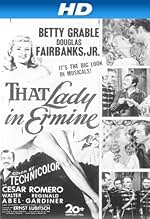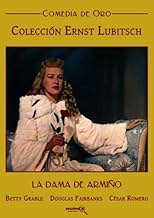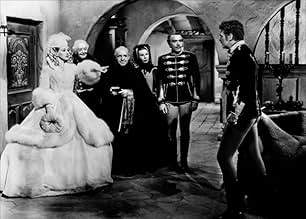That Lady in Ermine tells two parallel stories, both taking place in the small Mittel-European duchy of Bergamo, with one set in the 19th century and the other in the 16th.That Lady in Ermine tells two parallel stories, both taking place in the small Mittel-European duchy of Bergamo, with one set in the 19th century and the other in the 16th.That Lady in Ermine tells two parallel stories, both taking place in the small Mittel-European duchy of Bergamo, with one set in the 19th century and the other in the 16th.
- Nominated for 1 Oscar
- 2 nominations total
Lester Allen
- Jester
- (uncredited)
Mary Bear
- Isabella - Ancestor
- (uncredited)
David Bond
- Gabor
- (uncredited)
Harry Carter
- Staff Officer
- (uncredited)
Harry Cording
- Orlando - Ancestor
- (uncredited)
Herbert Evans
- Ancestor
- (uncredited)
Jack George
- Count Giovanni - Ancestor
- (uncredited)
Don Haggerty
- Staff Officer
- (uncredited)
Joe Haworth
- Soldier
- (uncredited)
Ray Hyke
- Albert's Knight
- (uncredited)
- Directors
- Writers
- All cast & crew
- Production, box office & more at IMDbPro
Featured review
Ernst Lubitsch's style permeates this unjustly forgotten movie, from a different age of cinema. Oddly enough, any old film noir (or just crime-oriented) feature from its age is revered on a pedestal today, while this wonderful 20th Century-Fox big-budget effort stirs little interest.
It is a remake of a 1927 silent film of the same title, a Corinne Griffith star vehicle from First National Pictures, the distributor that later became part of Warner Brothers. It's a lost film, perhaps because a silent movie of an operetta was hopelessly dated even then. Lubitsch includes fantasy and satire here, with the play-acting performances of stars Grable and Fairbanks delightful in that they make fun of the antiquated Period Costume Film cliches, while simultaneously creating warm and empathetic characters. The elements of satire have given way in modern cinema to vulgarity, as evidenced in the work of Mel Brooks (who remade Lubtisch's hit "To Be Or Not to Be") or my favorite director Ken Russell, yet Lubitsch is able to maintain the high ground even in the silliest of scenes, perhaps aided by the censorship of his day.
The Technicolor photography (by Leon Shamroy) remains stunning and just what any film buff should admire. A couple of oddities struck me as I finally saw this movie, so many decades after release, first the foot-fetish theme that instantly suggests Luis Bunuel, who was working in Hollywood during this period. And by some odd coincidence, the starting point for the movie's fantasy element is the stunning portrait of Gable as a 17th Century ancestor of her main character, which comes to life occasionally. Fairbanks' infatuation with the lady in the portrait is the same starting point as Preminger's greatest movie, "Laura", and Otto ended up completing "Ermine" after Lubitsch's sudden death at the age of 55.
It is a remake of a 1927 silent film of the same title, a Corinne Griffith star vehicle from First National Pictures, the distributor that later became part of Warner Brothers. It's a lost film, perhaps because a silent movie of an operetta was hopelessly dated even then. Lubitsch includes fantasy and satire here, with the play-acting performances of stars Grable and Fairbanks delightful in that they make fun of the antiquated Period Costume Film cliches, while simultaneously creating warm and empathetic characters. The elements of satire have given way in modern cinema to vulgarity, as evidenced in the work of Mel Brooks (who remade Lubtisch's hit "To Be Or Not to Be") or my favorite director Ken Russell, yet Lubitsch is able to maintain the high ground even in the silliest of scenes, perhaps aided by the censorship of his day.
The Technicolor photography (by Leon Shamroy) remains stunning and just what any film buff should admire. A couple of oddities struck me as I finally saw this movie, so many decades after release, first the foot-fetish theme that instantly suggests Luis Bunuel, who was working in Hollywood during this period. And by some odd coincidence, the starting point for the movie's fantasy element is the stunning portrait of Gable as a 17th Century ancestor of her main character, which comes to life occasionally. Fairbanks' infatuation with the lady in the portrait is the same starting point as Preminger's greatest movie, "Laura", and Otto ended up completing "Ermine" after Lubitsch's sudden death at the age of 55.
Storyline
Did you know
- TriviaIn later years Betty Grable said it was her least favorite of all her movies.
- GoofsIf you watch when the Lady in Ermine is dancing with Colonel Ladislas Karolyi Teglas / The Duke her shoes change from the heels to wedges.
- Quotes
Col. Ladislas Karolyi Teglas: If one is in love, one doesn't need an umbrella.
- ConnectionsFeatured in The Costume Designer (1950)
- SoundtracksOoh! What I'll Do (To That Wild Hungarian)
(uncredited)
Written by Friedrich Hollaender
Lyrics Leo Robin
Sung by Betty Grable and chorus
Danced by Betty Grable and Douglas Fairbanks Jr.
- How long is That Lady in Ermine?Powered by Alexa
Details
- Release date
- Country of origin
- Language
- Also known as
- This Is the Moment
- Filming locations
- Production company
- See more company credits at IMDbPro
Box office
- Budget
- $2,484,000 (estimated)
- Runtime1 hour 29 minutes
- Color
- Aspect ratio
- 1.37 : 1
Contribute to this page
Suggest an edit or add missing content


































